The world thinks it’s got Detroit all figured out – Protomartyr know that it hasn’t
We're not new here: a weekend in the Motor City with a band who know it best
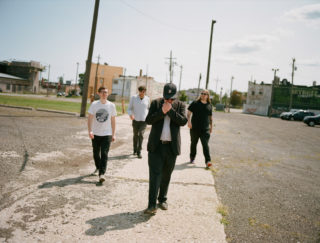
We're not new here: a weekend in the Motor City with a band who know it best
In 2010, documentary filmmaker Julien Temple made Requiem For Detroit?, informing my image of the Motor City. Before then, Detroit to me was Motown and Iggy & The Stooges. I knew that it was once the centre of the automobile industry but I didn’t care much about that. In terms of modern-day Detroit, I hadn’t given it a second thought. It turned out that neither had anyone else – not even a United States that had prospered so much from its capital boom and cultural legacy; not even the suburbs of the city just a few miles away.
Temple’s film is an excellent one, and more respectful than others have been in ghoulishly recounting Detroit’s traumatic last century and decline. It’s important that the question mark in its title is noted, and the documentary ends on hopeful footage of residents farming crops on the city’s countless empty lots. And yet, Requiem For Detroit? is incapable of not stoking the singular image of the city. It can’t help but stick to a script that’s been copied and recopied by every newspaper article about Detroit in the last 15 years, probably because the story is so good, by which I mean it’s unbelievable.
It always starts with Henry Ford’s first mass production line in 1913 and the genie that it let out of the bottle; the birth of consumerism and common aspiration and how the motorcar built Detroit quickly and crushed it slowly. Along the way the city experienced mass migration from the South, bringing with it poisonous racial prejudice that’s never gone away, ‘white flight’, the Great Depression, two fuel crises that put paid to the city’s cash cow of American-made cars, spiralling poverty and the crack epidemic of the 1980s that destroyed so many inner-city black neighbourhoods across the United States. Even the good times (the rapid expansion of Ford, General Motors and Chrysler into the 1920s; the lucrative illegal liquor that flooded the city from Canada in the 1930s prohibition era – 75% of the entire country’s supply) would serve to torment Detroit, building it up to knock it down.
But most important is how the story of Detroit always ends – with a city abandoned. With hundreds of homes burnt out and bulldozed. With one house in every three derelict. With nature reclaiming the sidewalks of entire blocks unoccupied for decades.
We’ve become gleefully fascinated by this image of Detroit; morbidly pleased that a place like this should exist in our lifetimes – a real life movie set of a post-apocalyptic, post-capitalist America. One look at the dramatic shape of Detroit and it’s easy to see how the rigidly desolate image of the city has become king, however insensitive it encourages us to be towards it and the thousands of people still living there.
It would be dishonest to say that the intensity of abandonment is overstated; the shock of it not so great; the prairie hum of the cicadas and crickets in the expanses of misplaced long grass not out of context and strange. And yet, of course, Detroit as a ruin is only part of its reality.
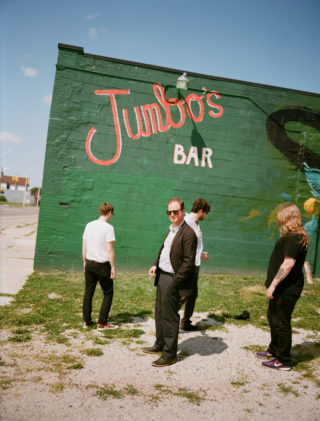
Also in 2010, Protomartyr played their first ever show, at the Lager House on Michigan Avenue, where we meet for lunch on our final day together. Having never been in a band before, and nervous to be singing in front of people for the very first time, Joe Casey preoccupied himself that night with planning his entrance. First he’d get drunk, then he’d remain sat at the bar in the next room whilst guitarist Greg Ahee and drummer Alex Leonard started to play without him. Once it finally felt like there was nothing else for it, and out of time to scull another drink, he pushed through the crowd and onto the stage. It must have looked pretty good because Scott Davidson was in the room that night and later became the band’s bassist.
Casey has remained a nervous performer ever since. He says that he doesn’t need to get as drunk as he used to but that he still removes his glasses so that he can’t see the audience so well. His awkward style (eyes down or closed as he walks in circles clasping a beer and muttering to himself) has become a huge part of Protomartyr’s identity – a group that are constantly told by the music press that they don’t look like a band. “People say I look so nonchalant, like I don’t care,” he says. “I wouldn’t get up on stage if I didn’t care, y’know? If I didn’t care I’d have a lawn chair out there.” He tells me about the most captivating performance he’s seen, from a band that’s so clearly informed his vocal style and certain dry elements of Protomartyr’s music. The last time The Fall came to the States, Mark E. Smith had broken his hip. “The whole show he was sitting on stage with a table up there, and he was just folding and unfolding this bar napkin. Just folding and unfolding. To me, it was so riveting.”
Today, the Lager House has been touched but not yet spoilt by gentrification. It’s a nice, two-room venue with a couple of fake guitars stuck to the walls in the bar and gig posters as wallpaper in the live room, which makes it sound inaccurately like Hard Rock Cafe. The band still like it enough but if there’s such a thing as the Protomartyr clubhouse it’s Jumbo’s in a neighbourhood in Midtown where I imagine gentrification may never reach.
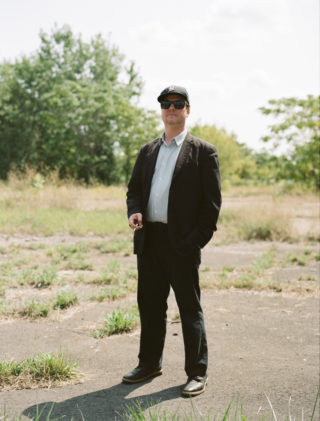
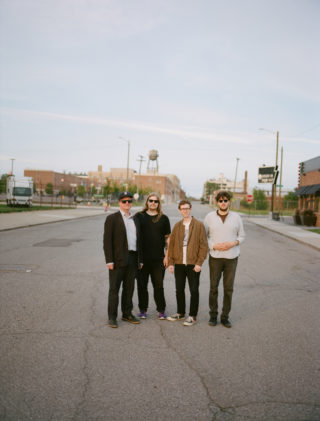
I arrange to first meet the band there on Friday night, so photographer David Cortes and I take a look at Google Maps, guess at it being around a 30-minute walk from our apartment and choose to ignore the many hysterical Trip Advisor comments we’ve read about how dangerous it is to walk around Detroit. A few blocks in, I’m aware that we’re the only two people on the street in any given direction. It’s 6:45pm and a beautiful late summer evening in what was once the fourth largest city in America – such isolation in a built up area feels alien and sketchy as we witness Detroit’s ghostly nature for the first time. As we get closer to the bar and approach groups of people hanging out in small pockets on the street it’s hard to know whether to feel more or less safe for the company – only clumsily like the outsiders we obviously are.
Flanked by two empty plots of land, we reach the giant shoebox building of Jumbo’s, note the bricked-up windows and blink our way into the long, thin, black room where the band are sat at the bar. When I tell Casey that we’d walked from Corktown, he says: “Oooh – walking is not very Detroit.”
We spend the night drinking in Jumbo’s small, grassy side garden. I instantly like the band, who are self-deprecating, very funny, laugh a lot and are clearly best friends, and the bar that they describe as “distinctively average, like us.” They played early shows here, too, in what was once a speakeasy and later the meeting point for Detroit’s boozy transvestites. The doorman comes over and shakes all of our hands one by one, saying, “how are my young people, doing?” which makes us all feel good. Jumbo’s owner, Cindy, comes out too, to unroll and show me a poster of the band’s first single launch party, which she’s kept since 2011. It means a lot to a band who named a song on their debut album ‘Jumbo’s’.
Outside, the band riff on a movie pitch called Alien Vs Nark (as sci-fi buddy movies set in a high school go, I reckon it’s got a chance of being the best), plan what and where we’ll eat over the weekend and oblige in giving me a brief history of Detroit, from the handful of billionaires who’ve started to buy up swathes of town and needlessly displacing residents in a city were space is in abundance, to the prevalent racism that has seen the introduction of the Qline – a streetcar that runs from suburbs to city, the band say, so that white business people don’t have to get on the buses that black people ride (a truth that I am shocked by, perhaps naively so, and one that we’ll discuss over the next couple of days).
“Detroit is really changing,” says Leonard before we leave. “If you had walked here from where you’re staying five years ago, there’s a good chance that you would have been murdered.” We get an Uber home.
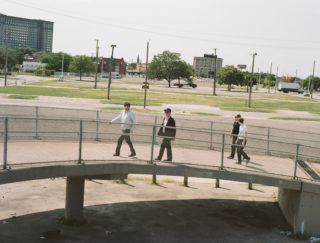
Protomartyr are Detroit lifers, although they’d never call themselves that. In New York you can be from Brooklyn or the Bronx or far away in Rockaway Beach and still simply be from New York; Detroit is built differently. The cultural divide is so strong here – the distribution of wealth so extreme – that it’s split into city and suburbs. You’re from one or the other and broadly speaking which comes down to the colour of your skin, with the most notorious demarcation point being 8 Mile in the north.
The members of Protomartyr all live in the city and attended the same all-boys high school just inside the city limits on 7 Mile. Still, out of respect for the hardship forever endured here they’ve always made a point of specifying their upbringings in the affluent suburbs. “We want to downplay when people talk about us being gritty,” Casey tells me at one point. “Some people think we’re working in the factory all day and at night we rock and roll.”
On Saturday morning Leonard and Ahee pick me up in Leonard’s grandmother’s car and we drive to Dearborn on the western border of Detroit for lunch at the band’s favourite Lebanese meat market. Leonard jokes about the dents in the car and over food the band tell me a few stories of car crime they’ve experienced – a prevalent problem in the city. They’ve all returned to vehicles to find the windows smashed so these days they often leave the doors unlocked to allow thieves to snoop around their empty cars without causing the damage. A friend adopted this approach, too, to find that someone had taken a shit on his seat. Casey’s mother once had her car stolen in front of her by a man who first helped her load her shopping into her boot. Leonard reasons that living in Detroit is so cheap in so many other ways – “you can buy groceries for nothing” – that people are happy to factor in the extortionate car insurance as a cost of living. On Sunday we stand around Casey’s Ford Saturn and he shows us a bullet hole in its side – he doesn’t know when or where it happened.
Dearborn is Henry Ford country: where he was born, buried and would build his company headquarters. A city with a large Lebanese, Iraqi and Syrian population, it also once typified intolerance as Ford developed Dearborn for his ballooning car manufacturing plant in the early 1900s. Offering double the standard wage, Ford attracted more than his fair share of workers during the Great Migration from the rural South from 1916 onwards. Only those that were white would live in Dearborn (with black families consigned to Inkster, further west), bringing to Detroit an early incarnation of segregation that’s never really gone away. The KKK rose; 1943 brought with it the city’s first race riot; and a second during the Civil Right’s Movement in 1967.
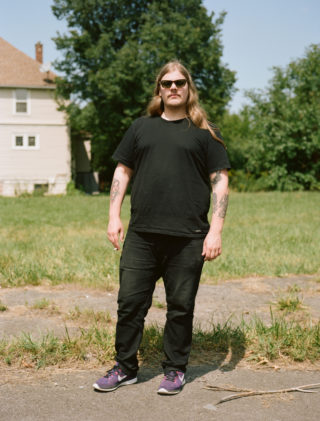
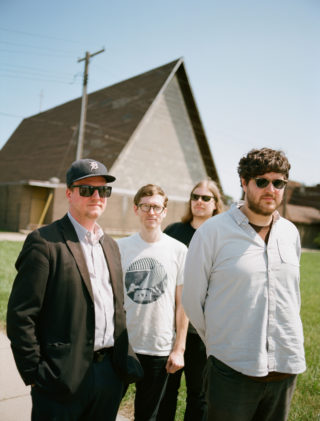
When Casey talks about the Detroit of his graduation year (1995) he talks about how vastly different it is to the city of today. Beyond some of the abandoned sky scrapers downtown having trees growing out of the top of them, kids from schools two blocks from his wouldn’t be allowed to visit because it was one street the wrong side of 8 Mile. “By then, Detroit had been abandoned by the outside world.”
“There were parts of Detroit that were dangerous,” he says, “but it comes down to racism. Detroit is now probably 80% – 85% black and then it was probably 90%.”
“There’s still absolutely racism between the suburbs and the city,” says Ahee, who tells me of a planned subway system that was voted down by the suburbs on account of it greater connecting it and the city and its residence, “it’s just shifted a little bit because it’s not Detroit as a whole that they’re afraid of now. Now it’s like, ‘Downtown is incredible; there’re all these restaurants!’ But the places these people are going to, a vast majority of the people in them are white. 95% I’d say, in a city that, as Joe says, is 85% black. So you notice that the places they are going are the places that all the white people are going to, and that’s not a coincidence.” He says how, along with the Qline streetcar, the recent restructuring of downtown has been to aid people from the suburbs who want to see a ballgame or watch the Detroit Lions without having to unnecessarily be on the street. So there are tunnels and the strange, dystopian monorail that glides from office to office, called The People Mover.
“The population of the city is still going down,” says Casey (a popular statistic in the decline of Detroit is how it’s a city made for 2 million people and is currently inhabited by under 700,000). “White flight pretty much happened right after World War II. After the riots a lot of people turned their backs on the city, thinking that the lunatics had taken over the asylum. And then when we had our first black mayor [Coleman Young, elected in 1973], that was the final straw. They still hate Coleman and think he caused all these problems. People say, ‘oh, he was so corrupt.’ Well, every mayor before him was just as corrupt – but they were white guys.”
“I can see people in the suburbs becoming less afraid to come into Detroit,” says Ahee, “not because they’re less racist, because there are more white people there.”
“When people say, ‘Oh I thought we were passed racism,’ it’s like, ‘What?!’” says Davidson. “‘You must live some place where you can have that thought, but you can’t have that thought in Detroit.’”
Along with the introduction of cheap, fuel-efficient, foreign-made cars, which arrived off the back of the 1973 fuel crisis and crippled Detroit’s world-defining automobile industry, the bleak reality of white flight and racism does little to challenge the reputation of a city that is tense and tough to live in. But that’s not really a narrative that the people here deny or are sick of being told back to them. What they’re really sick of – Protomartyr included – is the misguided notion of being ‘saved’ by a slow-moving tide of gentrification, or forgotten altogether. After all, so striking is this image of a city abandoned that it’s easy to forget that 700,000 people do still live here – no small number to be overlooked for the wonder of an empty street or a decaying, grand theatre repurposed as a car park.
“It’s really frustrating,” Ahee sighs. “There are dozens of reasons why the city has had the issues it’s had. It’s a complicated litany of reasons. People always want to narrow it down to a corrupt mayor or the collapse of the auto industry. It’s the same thing with the state of the city now, where people want to project their own narrative on something that is far more complicated than a pull quote. Detroiters – and specifically not myself but people who grew up in the city and have dealt with struggles I’ve never dealt with – have every right to be defensive of an outsider coming in and saying, ‘this is your problem,’ or, ‘this is your life,’ when they don’t know them at all. And to varying degrees I’m sure everyone deals with that, but here it’s always felt that there’s more of a spotlight and more of a desire for outsiders to project.”
“We’re happy for people to move into the city – everyone likes a nice restaurant,” says Casey. “But what’s happening is that these people are coming in and their narrative is, ‘Detroit is a clean slate – you can come here and do whatever you want.’ They think the city is wide open, and that’s all wrong. They’re negating the people who’ve lived here who’ve been through all of this. There’s a lot of saviour complexes that people have – ‘I made a difference. I opened up my fancy coffee shop and I saved the city.’ It’s not that obvious but that tone is there and that frustrates people. That’s going to become an issue over the next couple of years – this tension is building.”
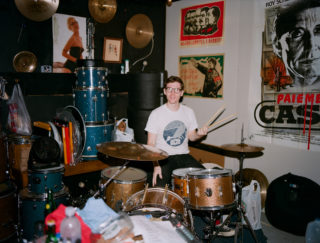
The band say that ‘ruin porn’ has become more and more popular over the last 15 years, something that I’m guilty of myself when I take a few photos of the vast, collapsing Packard Plant one morning, unable to resist its frightening size and complete desertion.
At Ahee’s house he hastens to state that marvelling at the destruction of Detroit is not the same as visiting the Coliseum. “It feels especially gross,” he says, “because people are coming in and viewing parts of the city like it’s ancient Rome, when, really, people are still dealing with the consequences of these places being burnt down and abandoned. People can feel like they’re in a zoo or part of an exhibit in a museum. You have tours coming in either to just feel sorry for you or think that they can help you, and that’s not good for anyone.”
When people graduate school and college in Detroit the next thing they do is leave town. Or at least that’s how it was when Casey finished his education as a film graduate. But Casey didn’t leave and felt like a failure because of it, regardless of family obligations that affected his decision not to follow classmates to Chicago, which included caring for his mother suffering from Alzheimer’s.
By the time Ahee and Leonard left the same school nine years later (with Davidson one more year behind them), attitudes had changed. The financial crash was upon us – why bother moving to a more expensive city to be unemployed when you can do that in Detroit?
Casey was 32 when he first considered being in a band, a fact that is more inspiring than it’s given credit for. He met Ahee working another in a long line of shitty jobs – as a doorman at the Gem Theatre downtown. “‘The Rat Pack Comes Back’ was one of the better shows,” he says, describing the coach-loads of pensioners that would file pass him for dinner and a crap play each night. He half jokes that it’s when he started wearing suits, which people seem fixated by along with his age. The truth is that Casey, whose soft speaking voice and likeably, mellow temperament somehow makes way for the dishevelled man barking on stage, doesn’t look 9 years older than the rest of the band. He does, however, have a problem with grown men, as he sees it, dressing like children.
He convinced Ahee and Leonard to allow him to sing a couple of songs with their band, Butt Babies, although under a different name to ensure that the booking counted as two separate acts, meaning double the amount of free beer tokens. Essentially, Casey would jump on stage at the end of a Butt Babies show to shout his way through a track or two, but he was starting to see how a band could be an outlet for his love of writing and, in the case of designing gig posters and artwork (something he still does today), his passion for art, too.
With Davidson, Protomartyr developed a wiry post-punk sound more inline with 1980s Manchester than anything that’s come from the Motor City before. Casey specifically wanted the band to sound like an early incarnation of The Fall, and at times they do. Ahee is a Smiths fan and his guitar sounds more and more like it. Perhaps it’s just context, but Davidson’s basslines often recall those of Peter Hook or The Cure when they weren’t writing a happy-sad hit single. When Protomartyr have sounded like an American band it’s been the decidedly European-sounding Pere Ubu. And yet they’re typically described as “the sound of abandoned buildings,” or a group that could have only come from Detroit.
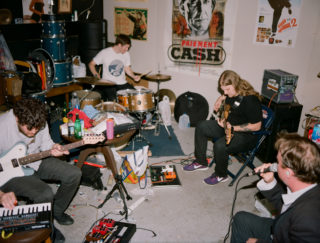
On Saturday afternoon we drive to band practice at Protomartyr’s relatively new rehearsal space, back past a building that’s come to symbolise the decline of Detroit – the imposing Michigan Central train station that went out of business in 1988. A short-cut to inaccurately define the city, the people of Detroit have come to despise this impressive structure, owned now by unpopular billionaire Manuel ‘Matty’ Moroun, whose association with the building has connected it to greed, for many.
Previously, the band would practice in Davidson’s basement; before that, a shady warehouse that they were pretty sure was a brothel, and an earlier spot that was so cold in the brutal winters of Michigan that it shaped the band’s early short songs, so they could practice them and leave as quickly as possible. This new space – which they’ve made homely with framed watercolours, Soviet propaganda posters and a Nintendo 64 – used to be an optician’s, which explains the picture on the wall of Kate Moss in Gucci glasses.
The band fly through new, fourth album ‘Relatives In Descent’, maybe feeling awkward that I’m enjoying it so much. It’s a brilliant record – Protomartyr’s best.
They’ve never been a band of one stringent pace, but on ‘Relatives In Descent’ they explore the dynamics of post-punk more than ever and often within any given song. ‘A Private Understanding’, for example, trudges through oil and explodes on a chorus that becomes an unlikely instrumental coda. ‘Here Is The Thing’ incessantly jabbers (a slack-jawed Casey in full Mark E. Smith mode) and sounds almost out of time when it’s not locked into Ahee’s carving lead guitar. ‘Windsor Hum’ is the complete opposite – a slow-building doomy chug that features two strange, ringing notes and eventually reaches the point where an irate Casey is goaded into yelling: “Want, want, want, want, want what you’re given / Need, need, need, need, need what you’ll never have!” Perhaps even more uncharacteristic for the band is almost-ballad ‘Night-Blooming Cereus’, which sounds like a slow Horrors song and might or might not be directly inspired by the landscape of Detroit and hope in desolate places. There’s also a point where they get kinda groovy in a Libertines way, on a track called ‘Caitriona’.
Ahee explains how the record’s droning bee-swarm elements are inspired by Mica Levi’s score for Under The Skin, and the band note that ‘Relatives In Descent’’s less claustrophobic feel is a direct result of making the album in LA in the relatively luxurious timeframe of two weeks (they recorded their debut album in 4 hours).
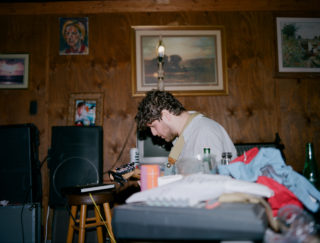
For Casey’s part, he still sloshes and slurs his abstract lyrics in a way that makes his words rhyme even when they don’t. They remain difficult to decipher, and even when you’ve got them written down in front of you they welcome listener interpretation. That said, the theme of resignation – a recurring one in Protomartyr songs – is still to be clearly heard. As subject matters in popular music go, giving up is a pretty unique one. “Music is usually about ‘you are great,’ or, ‘you’ve got a ten-inch dick,’” says Casey. “I can’t relate to that stuff – I’ve got to write about the stuff I know.”
People are likely to hear ‘Relatives In Descent’ and label it a record for our time, but you could easily say that of any of Protomartyr’s previous albums in relation to where we find ourselves today. It feels more like the world has caught up with the band. As they put it, the records before were warning of the times that were coming and now they’re here – it caused Casey to abort his original plan to write a fictional album and see what type of emotional heft it had. Knowing that he chooses to not write overtly political songs, though, I ask if he’s finding its more difficult to do, particularly regarding the boring omnipresence of Trump.
“I believe there’s always been politics in [the songs], but you should be careful with it,” he says. “Resignation is still there in this record, but I didn’t want to be too specific on the political stuff because there’s so much doom and gloom and it’s beyond our control.
“I won’t sugar coat it for you, but ‘Up The Tower’ [a track in which Casey repeatedly shouts ‘Knock it down!’ and ‘Throw him out!’] is definitely about Trump, but I don’t want to even say his name. I know that every interview will be, ‘what do you think about Trump?’ ‘Well, he’s shit.’ It’s not like if we get rid of Trump tomorrow everything will be ok, though. A lot of bands are feeling the pressure to say this is their anti-Trump record, but Trump is the result of something else. He’s only one aspect of this huge problem. The guy loves attention, so why ruin our lovely interview about our band talking about him?”
“Trump is irrelevant,” says Ahee. “He’s a narcissistic lunatic who should have been shut down before he even had a reality show – the issue is what he has awoken in this country. How did he get in? The answer to that is what’s terrifying and it’s not going to go away when he does… It’s also fucked up that now saying that racism is wrong or that black lives matters is considered a political stance.”
What ‘Relatives In Descent’ chooses to explore, then, via Casey’s literary mind that he chooses to downplay for fear of seeming a sneering book snob, is the subject of truth in a time when we’re questioning its existence. Casey says that it’s not a concept album, although a number of the tracks have been almost subconsciously written in twos and paired up – two versions of the same story. He explains that opening song ‘A Private Understanding’ is an abstract idea about truth (and how we can only be sure of what we perceive as factual), which is followed by ‘Here Is The Thing’ – the exact same story from a drunk’s point of view. Tracks 3 and 4 (‘My Children’ and ‘Caitriona’) are about corrupting your own children and children letting their parents down; 5 & 6 (‘The Chuckler’ and ‘Windsor Hum’): respectively, tales of desperately trying to laugh in the face of a world falling apart and the message of denial that America transmits across the globe. The album ends on ‘Half Sister’, which trolls fake news (of a horse struck by lightning that begins to talk) and neatly calls back to ‘A Private Understanding’. “I hate movies where something magic happens and then all these animals start to talk,” says Casey. “I would think that if a horse started to talk it would be the most disturbing sound [he starts shrieking and retching, to the laughter of everyone]. So this horse gets struck by lightning and starts speaking in a foreign language. When they finally work out what it’s saying they realise it’s that people are evil.”
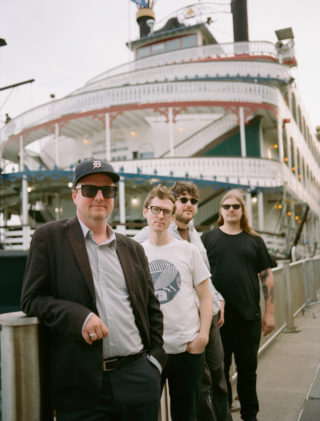
After practice and a few games of NFL Blitz on the N64, we spend an hour aboard The Detroit Princess, a 200 foot, 4 storey riverboat that the band have hired to launch their new album on September 22. Metz and Preoccupations from across the river in Canada will also play, as well as ADULT and Detroit’s very own Tyvek, who first inspired Casey to form a band when they took him to Europe in their road crew. Before the Princess sets sail on a Motown-themed cruise this evening, Protomartyr have a photo shoot for local paper the Detroit Metro Times. As we leave the boat a passer-by asks if they’re a band, and so do the barmaids in the first bar we drive to.
It’s quiet at the waterfront, despite more beautiful weather on a Saturday night. Casey tells me how his father spoke of the same desertion of downtown at weekends even in Detroit’s 1950s heyday.
At 9pm we realise that tonight is the Mayweather/McGregor fight and, despite none of us giving a shit about boxing, we collectively become completely obsessed with trying to watch it via a number of different illegal streams on our phones. For three hours we bounce between Youtube live links and Periscope profiles that typically drop off after 10 minutes or so. We think we find our man in some guy called ‘Fishman’, but eventually he gets shut down too. By midnight and the sound of the first bell we’re using a plant pot as a TV stand in the beer garden of Bumbo’s (not Jumbo’s), huddled with a group of strangers and couple of band friends, enjoying the sweet ecstasy of watching men punch each other in the face having not paid a penny of the pay-per-view fee. As much as anything, this, of course, is what Detroit is about.